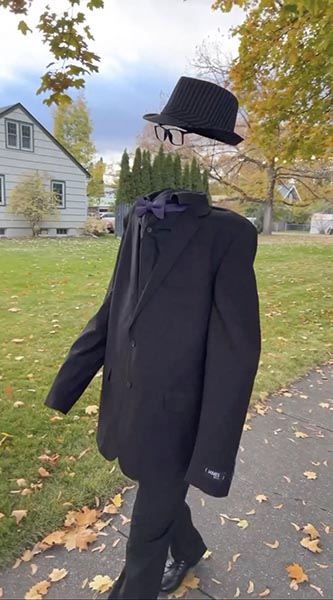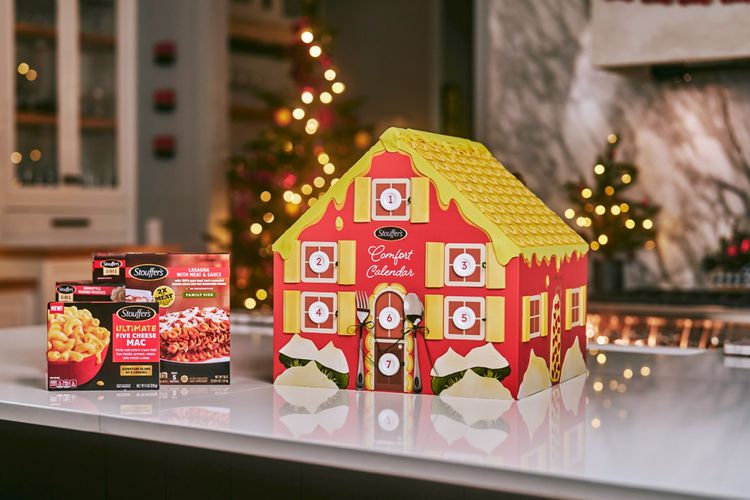
Canva Goes to School
Earlier this year, Monotype and Canva struck up a partnership in which Monotype would make 1,100 fonts available on the platform. Now, via Print magazine, the two have expanded their relationship to add an entire five-part “type curriculum” for schools.
Co-authored by Monotype and Canva, the educational series includes lecture topics, in-class discussions, and activities for students to explore and expand their relationship to design. The five modules are Type 101, Type All Over the World, The Psychology of Typography, Type and Branding, and Design Thinking.
“Canva for Education” was launched in 2019.
Teachers and students now make up nearly a third of its user community. The educational platform has also announced collaborations with NASA and the New York Times.
Livin’ On the Fridge
A fun thing to play around with are those fridge magnet poetry sets. Alas, some modern refrigerators aren’t magnetic. So what to do? Replace the fridge? Seems kind of silly.
Happily, there is now an online fridge magnet poetry simulator. Drag nouns, verbs, adjectives, and adverbs onto the blank canvas, and arrange as desired. Hours of fun.

Adds Boing Boing:
I find that pulling words from a word bank helps my writers block when it comes to making poetry.
If you want to try making poetry but don't know where to start, this is a simple way to do so. It also works great for short stories, coming up with names for things, or just goofing around.
Movable Feasts
Umm… Why? Says Ars Technica:
Imagine sitting down to a fine-dining meal in which droplets of sauce dynamically move basil leaves and other garnishes around the plate in preprogrammed patterns.
Sounds like someone had too much wine before dinner. But, no, this is a project called “Dancing Delicacies,” a “computational food project” being developed by researchers at Monash University’s Exertion Games Lab, Carnegie Mellon University’s Morphing Matter Lab, and Gaudi Labs in Switzerland. The goal is to “turn meals into interactive performance art.” Sounds terrifying, but apparently it’s not.
“Cooking and eating is more than simply producing a dish and then facilitating energy intake,” co-author Floyd Mueller of Monash told Forbes. “It is about sharing, caring, crafting, slowing down and self-expression, and Dancing Delicacies aims to highlight these virtues at a time when they are often forgotten. The integration of food and computing will transform how we understand both computing and food as not two very different things, but a new frontier that combines the best of both.”
To this end, they have developed a 3D-printed plate that uses electrical voltage to manipulate liquid droplets and thus have buts of sauce move about. Bringing new meaning to the term “Wavy Gravy.” This is not the first of this sort of thing.
Chefs have been working with this kind of innovation for years via the molecular gastronomy and molecular mixology movements, creating a “Flor de Caco” dessert in which a cocoa bean expands like a flower when exposed to hot chocolate sauce, for instance. Then there was that cocktail (the “Disco Sour”) that changed color when blended with citrus, thanks to the incorporation of butterfly pea flower tea, which is a pH-sensitive ingredient.
And, of course…a shape-shifting fork!
On the technology side, in 2014, MIT's Media Matters Lab experimented with a shape-changing fork that inflated depending on how fast a person ate. Another fork design was outfitted with electronics, in which an LED changed from red to green when users touched a food item with a conductive element, indicating how much water was in the food.
OK, back to the 3D-printed plate.
“Some food items are in the form of aqueous droplets that can be manipulated using EWOD technology embedded in the plate,” the authors wrote. “A chef can ‘program’ the dish during the process of its creation and choreograph the diner’s encounters within the dining trajectories. Based on how the dish has been programmed, the diner can ‘reconfigure’ it to enjoy different eating trajectories.”
Not sure that having a meal “programmed” is a great idea. Will we get an error message from our dinner? And what about catching a food-borne computer virus? Of course, a restaurant with bad service can always say, “Sorry, your meal is in the cloud.” SaaS—supper as a service!
Roasting Pan
In advertising, we expect a certain amount of hyperbole, but when violating basic laws of physics is involved, perhaps an advertiser has gone too far. Take, for example, frying pan manufacturer SharkNinja. They made the claim that their cookware is heated to a temperature of 30,000 degrees Fahrenheit, a process that, says the company, fuses “plasma ceramic particles creating a super-hard, textured surface that interlocks with our exclusive coating for a superior bond.” Now, mind you, the surface of the Sun is 10,340 degrees Fahrenheit. At any rate, via The Verge, SharkNinja is being sued for deceptive advertising.
Brown argues that heating up SharkNinja’s pans to this temperature is a “physical impossibility,” given that aluminum vaporizes into gas at 4,478 degrees Fahrenheit.
Here’s the hysterical part:
The lawsuit also points out that SharkNinja advertises the pan as oven-safe up to only 500 degrees Fahrenheit.
Still, we’d bet you could really get your food to dance about at those temperatures.
Make the Stand
You know how it is. You’re out in the world, carrying a water bottle, and suddenly you decide that you need an iPhone stand or a tripod. What do you do? Well, via Core77, if you are carrying a Ringo water bottle, you’re in luck. Its cap features a magnetic ring that takes advantage of the iPhone’s MagSafe technology to let you attach it magnetically:

It is said to be stable regardless of how full the bottle is. A steal at $65 (although it’s not clear who is stealing from whom). For Android users, the company offers a Magnetic Booster Ring (sold separately for an extra $10) which can be attached to the back of the phone. Say what you will, but it attracted $330,269 on Kickstarter.
Adventures in Inventory Management
Do you like online adventure games? Inventory management? And the lower-res the better? If so, be sure to play Homeward, in which managing your possessions is half the game. Buy bread, pick mushrooms, annoy old women…the game has it all, but pitfalls abound.

Just like life, really.
Graphene Gets Warm
Was it a good week for graphene news? It’s always a good week for graphene news! More graphene-enhanced consumer products hitting the market—this time, a graphene-based heated jacket, just in time for winter From (who else?) Graphene-Info Kickstarter:
The weather can be unpredictable, your attire shouldn't be. Designed with cutting-edge technology, this jacket ensures you stay warm, dry and stylish, no matter what Mother Nature throws your way. With innovative graphene heat zones and 3 customizable warmth settings, the UZE Heated Jacket is your ultimate companion for your everyday adventure. No matter the occasion, your jacket adapts to you. Wear the future.
Pledge amounts start at $299. A steal!

Jeepers—you’d think they’d be a bit more excited.
Around the Webb, Part the Continuing: Jupiter v2
Says NASA: “NASA’s Webb Discovers New Feature in Jupiter’s Atmosphere.” Wow, we are just so used to everything being upgraded so regularly that even planets are adding new features.
The high-speed jet stream, which spans more than 3,000 miles (4,800 kilometers) wide, sits over Jupiter’s equator above the main cloud decks. The discovery of this jet is giving insights into how the layers of Jupiter’s famously turbulent atmosphere interact with each other, and how Webb is uniquely capable of tracking those features.

NASA, ESA, CSA, STScI, R. Hueso (University of the Basque Country), I. de Pater (University of California, Berkeley), T. Fouchet (Observatory of Paris), L. Fletcher (University of Leicester), M. Wong (University of California, Berkeley), J. DePasquale (STScI)
The newly discovered jet stream travels at about 320 miles per hour (515 kilometers per hour), twice the sustained winds of a Category 5 hurricane here on Earth. It is located around 25 miles (40 kilometers) above the clouds, in Jupiter’s lower stratosphere.
The things we can do.
Clean Up In Aisle 5
Last week, we linked to Japan’s haunted bathrooms, noting that it was a pretty weird place for ghosts to hang out. In Norway, however, the bathrooms are apparently ghost-free, but it’s the grocery stores you have to worry about. Well, one particular grocery store in a small Norwegian village near the Swedish border. At first, the store manager and other employees noticed some weird goings-on: irreparable electrical issues, mysteriously smashed flower pots, and “lurking, shadowy figures.” But then it got worse. Says Atlas Obscura:
When customers began experiencing odd things—the tipping point was a woman getting hit by flying potatoes—people far beyond the village took notice. Eventually, local media and even a Norwegian ghost-hunting show visited the store and conducted investigations, trying to capture video and audio footage confirming a ghostly presence.
And it turned out to be (and we say “it turned out to be”) not one, not two, but three ghosts.
Ghost hunters suggested that the hauntings were caused by three spirits. According to their investigation, the ghosts of a kindly married couple who ran the store from the 1950s until the 1970s were purportedly frustrated by new-fangled technology and were blamed for causing electrical systems, such as the store’s alarms, to go on the fritz. Some of the more malicious activity was deemed the work of the angry ghost of a man who’d frozen to death outside the store in 1962.
Interestingly, the investigation of the incidents led one ghosthunter to change his focus on the sociology of hauntings, or how these incidents affect the people relating them.
Davan shadowed the store’s employees and customers, interviewing them about what they’d seen and how it affected them. Sharing that you’re experiencing a different reality, he noted, can have harmful consequences. “People can think you’re crazy, it can affect your job opportunities and your relationships with other people,” Davan says.
At the same time, sharing your experiences with others who have had brushes with the unexplained can be reassuring. Åke says that while the store’s strange occurrences were unsettling—the experiences traumatized his sister in particular, who quit her job because of them—it helped him and his colleagues to know that they weren’t alone in their experiences.
Candy Land
Next week is Halloween, and no doubt the scare stories about razor blades in apples, poisoned candy, or otherwise harmful treats will be all over the media. These fears have been circulating for decades, but can you guess how many incidents of this sort there have been? None. There has never been a recorded incident of someone being poisoned or otherwise harmed by Halloween candy, except for perhaps a bellyache from overdoing it. Atlas Obscura explores where this myth came from, and why it continues. The term “Halloween sadism” was coined in 1974 to refer to “the act of passing out poisoned treats to children during trick-or-treating”—again, a thing that has never been reported as happening. But in fall 1982 in Chicago, things kicked into high.
Candy was a potential murder weapon. Apples might contain carefully concealed razor blades. Twizzlers might be laced with rat or ant poison. Mayor of Chicago Jane Byrne urged extreme caution and vigilance on Halloween, adding that if she had children, she would not allow them to accept any food items.
As the fear crept across the nation, towns nowhere near Chicago began to sound the alarm. In Trenton, governor of New Jersey Thomas Kean signed a bill imposing a mandatory six-month jail sentence on anyone convicted of handing out contaminated Halloween candy. In Vineland, a southern New Jersey city, Mayor Patrick Fiorilli imposed an outright ban on trick-or-treating, noting “what an opportunity this was for some nut to do something.” Local hospitals offered to X-ray children’s Halloween candy hauls.
The fear was triggered by a real incident in September 1982—although it had nothing to do with Halloween candy. Some of you may remember this:
Late in September, seven apparently healthy Chicagoans had died suddenly and inexplicably. It would not be long before authorities identified a common factor—all of the victims had taken capsules of Extra-Strength Tylenol before their sudden deaths. Toxicology studies revealed that someone had opened the capsules and replaced their contents with fatal doses of cyanide. To this day, no one has been charged with the crime.
It ended up being a one-off incident that still spooks people. Sociologist Joel Best has been tracking “Halloween sadism” for decades and has found that any reported incidents have ended up being hoaxes—often perpetrated by the kids themselves.
Of all the reports of a child being killed by Halloween sadism, not a single one has held up under inspection. Yet when October 31st rolls around, police stations, hospitals, and local news outlets continue to break out the perennial warnings about how to “protect children from poisoned candy.” Some police departments and hospitals lend further credibility to the myth by issuing “warning” press releases or offering to inspect candy.
So just let the kids have fun this Halloween.
Invisible Touch
So if you’re not scared of trick or treating and need a good costume, try this pretty convincing invisible man/woman get up devised by Montana-based interior decorator Jana Roach. Via Core 77:

Roach says she sourced everything from a thrift store, setting her back just $30.
Alternately, you could just stay home and then tell everyone afterward, “I went as the invisible man. Didn’t you see me?”
Cold Comfort
We have questions. Says Food & Wine: “Stouffer’s Releases Its First-Ever Advent Calendar, and It’s Filled With Frozen Food.”
Stouffer’s, that eternal staple of the frozen food aisle, has just dropped its first-ever advent calendar, the entree-and-side dish filled Stouffer’s Comfort Calendar. The calendar, which comes in a gingerbread-style house in Stouffer’s familiar color palette, is filled with seven different Stouffer’s favorites, including Family Size Macaroni and Cheese; Family Size Lasagna with Meat and Sauce; Stouffer’s Bowl-Fulls Chicken Bacon Ranch Bowl; Stouffer’s Sides Broccoli Cheddar Pasta Bake; Stouffer’s Sides Homestyle Mashed Potatoes; Stouffer’s Pepperoni French Bread Pizza; and Stouffer’s Ultimate Five-Cheese Mac.
OK…
“The busyness of the holiday season makes daily mealtime a challenge for many families," Nate Hill, Stouffer’s Vice President of Marketing and Portfolio Expansion, said in a statement. “Stouffer’s first-ever advent calendar aims to help families combat scratch cooking fatigue by delivering no-fuss, great-tasting meal solutions everyone will love.”
Let’s hope we never get too busy to cook a meal; that just sounds like hell. Anyway, what condition will the frozen food be in by the time you open the last door? Or is the calendar designed to go into the freezer? And, if so, how?
In an Instagram post about the calendar, the company said that the entrees and sides have been packed “with space-saving in mind,” in case you’re already playing a mental game of freezer Tetris as you try to figure out how this is all going to fit.

On second thought, we’ll just order out.
This Week in Printing, Publishing, and Media History
October 23
1959: "Weird Al" Yankovic born.
2012: After 38 years, the world’s first teletext service (BBC's Ceefax) ceases broadcast due to Northern Ireland completing the digital switchover.
October 24
1861: The first transcontinental telegraph line across the United States is completed.
1911: Orville Wright remains in the air nine minutes and 45 seconds in a glider at Kill Devil Hills, N.C.
1946: A camera on board the V-2 No. 13 rocket takes the first photograph of earth from outer space.

1991: American captain, screenwriter, and producer, creator of Star Trek, Gene Roddenberry dies (b. 1921).
2003: The Concorde makes its last commercial flight.
October 25
1977: Digital Equipment Corporation releases OpenVMS V1.0.
2001: Microsoft releases Windows XP, becoming one of Microsoft’s most successful operating systems.
October 26
1825: The Erie Canal opens, allowing direct passage from the Hudson River to Lake Erie.
1861: The Pony Express officially ceases operations.
1892: Ida B. Wells publishes Southern Horrors: Lynch Law in All Its Phases.
1946: Puerto Rican actress and author Holly Woodlawn born to walk on the wild side.
1958: Pan American Airways makes the first commercial flight of the Boeing 707 from New York City to Paris.
October 27
1858: Theodore Roosevelt born.
1904: The first underground New York City Subway line opens, later designated as the IRT Broadway–Seventh Avenue Line.
1914: Welsh poet and author Dylan Thomas born.
1923: American painter and sculptor Roy Lichtenstein born.
1932: American poet, novelist, and short story writer Sylvia Plath born.
1939: English actor, comedian, screenwriter, and producer John Cleese born.
1977: American journalist and author James M. Cain dies (b. 1892).
2004: The Boston Red Sox defeat the St. Louis Cardinals to win their first World Series in 86 years.
October 28
1726: The novel Gulliver’s Travels by Jonathan Swift is published.
1886: In New York Harbor, President Grover Cleveland dedicates the Statue of Liberty. The first ticker tape parade takes place in New York City when office workers spontaneously throw ticker tape into the streets as the statue is dedicated.
1899: German-American engineer, invented the Linotype machine Ottmar Mergenthaler dies (b. 1854).
October 29
1675: Leibniz makes the first use of the long s (∫) as a symbol of the integral in calculus.
1787: Mozart’s opera Don Giovanni receives its first performance in Prague.
1911: Hungarian-American publisher, lawyer, and politician, founded Pulitzer, Inc. Joseph Pulitzer dies (b. 1847).
1969: The first-ever computer-to-computer link is established on ARPANET, the precursor to the Internet.










Discussion
Join the discussion Sign In or Become a Member, doing so is simple and free